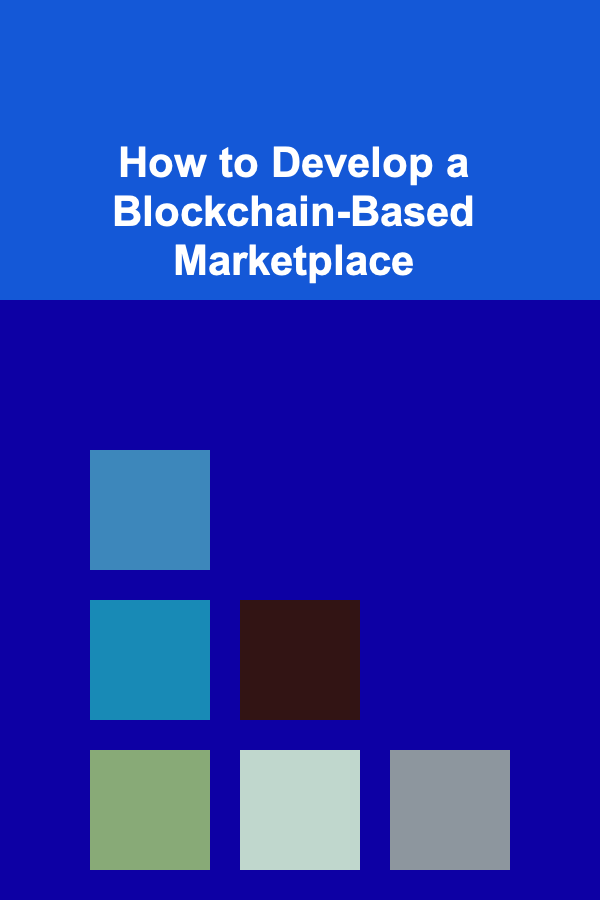
How to Develop a Blockchain-Based Marketplace
ebook include PDF & Audio bundle (Micro Guide)
$12.99$8.99
Limited Time Offer! Order within the next:

In recent years, blockchain technology has rapidly evolved from a niche concept associated with cryptocurrencies to a fundamental innovation capable of transforming industries. One of the most exciting applications of blockchain technology is the development of blockchain-based marketplaces. These decentralized platforms leverage the transparency, security, and immutability of blockchain to create trustless environments for transactions, removing the need for intermediaries and reducing the risks of fraud.
A blockchain-based marketplace provides a decentralized, peer-to-peer (P2P) platform for buying, selling, and trading goods or services. By integrating blockchain into the marketplace infrastructure, developers can create platforms that are more secure, efficient, and transparent than traditional online marketplaces.
In this article, we will explore the key concepts and components involved in developing a blockchain-based marketplace, including the technical aspects, benefits, and challenges. We will also provide a step-by-step guide for building a blockchain-powered marketplace, offering insights into how to leverage blockchain's potential to create a functional and scalable decentralized platform.
Understanding Blockchain Technology
Before diving into the development of a blockchain-based marketplace, it's important to understand the fundamental concepts of blockchain technology. Blockchain is essentially a distributed ledger system that enables secure and transparent transactions without the need for a central authority. It consists of a chain of blocks, each containing a list of transactions, which are linked together in a secure, immutable manner.
Key features of blockchain include:
- Decentralization: Instead of relying on a single central entity to control and verify transactions, blockchain distributes the responsibility across a network of nodes (computers). This decentralized nature removes the need for intermediaries and reduces the risks of fraud or manipulation.
- Transparency: All transactions on the blockchain are visible to participants in the network. This transparency ensures that the integrity of the system is maintained and fosters trust among users.
- Security: Blockchain uses cryptographic techniques to secure data, making it extremely difficult for unauthorized parties to alter or tamper with transactions.
- Immutability: Once a transaction is recorded on the blockchain, it cannot be changed or deleted. This ensures that all transaction history remains intact and auditable.
In the context of a marketplace, these features of blockchain technology enable trustless transactions between buyers and sellers. Both parties can verify the integrity of the transaction without relying on a third party, which is a key advantage over traditional centralized marketplaces.
Benefits of Blockchain-Based Marketplaces
The integration of blockchain technology into marketplace platforms offers several compelling advantages over traditional systems. Some of the most significant benefits include:
1. Decentralization
Traditional marketplaces are typically centralized, meaning that they are controlled by a central authority (such as Amazon, eBay, or Etsy). This central authority has control over the platform's rules, fees, and data. In contrast, a blockchain-based marketplace is decentralized, which means that there is no single entity controlling the platform. This creates a more democratic environment where participants have greater control over their transactions and interactions.
2. Enhanced Security
Security is a major concern for online marketplaces. Centralized platforms are often vulnerable to hacking, data breaches, and fraud. Blockchain technology provides a more secure environment for transactions. Each transaction is cryptographically signed and recorded on a public ledger, making it extremely difficult for malicious actors to tamper with the system. Furthermore, the decentralized nature of blockchain reduces the risks associated with a single point of failure.
3. Transparency and Trust
Blockchain's transparency feature ensures that all transactions are recorded on a public ledger that is visible to all participants. This creates a high level of trust among users, as they can independently verify the validity of each transaction. Buyers and sellers can be confident that they are engaging in fair and transparent exchanges, without the fear of being defrauded by the platform or other participants.
4. Reduced Transaction Fees
In traditional marketplaces, intermediaries such as payment processors and platform operators charge fees for facilitating transactions. These fees can add up, especially for small transactions. With blockchain-based marketplaces, many of these intermediaries are eliminated, allowing for peer-to-peer transactions with lower or even negligible fees. This makes the platform more attractive for both buyers and sellers.
5. Ownership and Control of Data
In centralized marketplaces, user data is typically controlled by the platform owner, who may monetize the data or use it in ways that users are unaware of. Blockchain-based marketplaces allow users to retain ownership and control of their data, which can be used to create more personalized and secure experiences without sacrificing privacy.
6. Faster Transactions
Blockchain technology can significantly reduce transaction times. Traditional payment systems, especially international ones, often involve delays due to intermediaries and cross-border regulations. Blockchain, particularly with the use of cryptocurrencies, allows for faster, borderless transactions that can be completed in seconds or minutes, regardless of geographical location.
Key Components of a Blockchain-Based Marketplace
Building a blockchain-based marketplace requires a deep understanding of various components, both technical and functional. Here are the key elements involved in the development of such a platform:
1. Smart Contracts
Smart contracts are self-executing contracts with the terms of the agreement directly written into code. These contracts run on blockchain platforms (such as Ethereum) and automatically execute when predefined conditions are met. Smart contracts are essential for blockchain-based marketplaces because they allow for automated, trustless transactions between buyers and sellers. For example, a smart contract can release payment to a seller only after the buyer confirms receipt of the goods or services, ensuring that both parties fulfill their obligations.
2. Decentralized Identity Verification
In a blockchain-based marketplace, it is important to verify the identity of participants to prevent fraud and ensure trust. Traditional marketplaces rely on central authorities to verify identities, but blockchain allows for decentralized identity verification through technologies like self-sovereign identity (SSI). SSI enables users to control their own identity information and share it securely when needed.
3. Payment Integration (Cryptocurrency and Fiat)
While blockchain-based marketplaces can use cryptocurrencies like Bitcoin or Ethereum for transactions, it's important to also consider how fiat currencies will be handled. Integrating both cryptocurrency and fiat payment options provides flexibility to users who may not be familiar or comfortable with digital currencies. Some platforms may also support stablecoins, which are cryptocurrencies pegged to traditional assets like the US Dollar, to provide stability in value.
4. Market Listings and Search Functionality
A marketplace needs a robust system for managing product listings, including the ability for sellers to create and manage their listings. This can be done using decentralized storage solutions like IPFS (InterPlanetary File System), which allows for distributed and secure storage of product images, descriptions, and other assets. A search engine should also be implemented to allow users to find products or services based on various criteria such as keywords, categories, and prices.
5. Escrow and Dispute Resolution Systems
In a decentralized marketplace, it's crucial to implement an escrow system to protect both buyers and sellers. An escrow service temporarily holds the buyer's payment until the seller has fulfilled their end of the transaction. If there is a dispute, a decentralized dispute resolution system can help resolve issues by utilizing community or algorithm-based arbitration processes.
6. Governance Model
A blockchain-based marketplace requires a clear governance model to ensure that decisions regarding platform upgrades, rules, and dispute resolution are made in a fair and transparent manner. Many decentralized platforms utilize DAO (Decentralized Autonomous Organizations) to allow users to participate in the governance process through voting and consensus mechanisms.
Steps to Build a Blockchain-Based Marketplace
Step 1: Choose the Right Blockchain Platform
The first step in building a blockchain-based marketplace is selecting the appropriate blockchain platform. Ethereum, with its robust smart contract capabilities, is a popular choice for decentralized applications (dApps), but other blockchains like Binance Smart Chain , Polkadot , or Solana may also be viable options depending on the specific needs of your marketplace.
Step 2: Develop Smart Contracts
Once the blockchain platform is chosen, you will need to develop the necessary smart contracts that govern the marketplace's functionality. This includes smart contracts for creating listings, executing transactions, handling payments, and enforcing the marketplace's rules.
Step 3: Build a User Interface (UI)
A user-friendly interface is essential for attracting users to your platform. The UI should be intuitive and easy to navigate, allowing users to browse listings, make payments, and interact with other users. The UI will interact with the blockchain backend via Web3.js or similar libraries, allowing users to interact with the decentralized network.
Step 4: Implement Payment Systems
Integrate cryptocurrency wallets to facilitate payments, as well as fiat payment gateways for users who prefer traditional payment methods. This will require integrating APIs and ensuring that both types of payments are handled securely and efficiently.
Step 5: Establish Security and Privacy Protocols
Security is critical in a blockchain-based marketplace. Implement encryption techniques for data storage and communication, along with decentralized identity verification systems to ensure the privacy and security of users.
Step 6: Test the Platform
Before launching the marketplace, conduct extensive testing to ensure that all components work as expected. This includes testing the smart contracts, payment systems, user interface, and dispute resolution mechanisms. It's important to identify and address any vulnerabilities or bugs before going live.
Step 7: Launch and Monitor
After testing and final adjustments, launch the marketplace. Post-launch, continuously monitor the platform's performance, user feedback, and security, making necessary updates as the platform evolves.
Conclusion
Developing a blockchain-based marketplace presents a unique opportunity to create a more transparent, secure, and efficient platform for buying and selling goods and services. By leveraging the power of blockchain technology, smart contracts, and decentralized governance, developers can build platforms that offer greater trust, lower fees, and improved user experiences compared to traditional centralized marketplaces. However, the development process involves several technical, legal, and operational challenges that must be carefully addressed to ensure the success of the platform.
By following the outlined steps and considering the key components and best practices, developers can build a blockchain-based marketplace that is not only functional and secure but also positioned for growth in the rapidly evolving digital economy.

How to Offer Online Fitness Coaching as a Side Hustle: An Actionable Guide
Read More
How to Properly Maintain Your Home's Fireplace
Read More
How to Find Free Community Events
Read More
How To Create a Healthy Work-Life Balance Remotely
Read More
Overcoming Perfectionism in Your Work: A Comprehensive Guide
Read More
How To Start Writing in Your Target Language
Read MoreOther Products

How to Offer Online Fitness Coaching as a Side Hustle: An Actionable Guide
Read More
How to Properly Maintain Your Home's Fireplace
Read More
How to Find Free Community Events
Read More
How To Create a Healthy Work-Life Balance Remotely
Read More
Overcoming Perfectionism in Your Work: A Comprehensive Guide
Read More